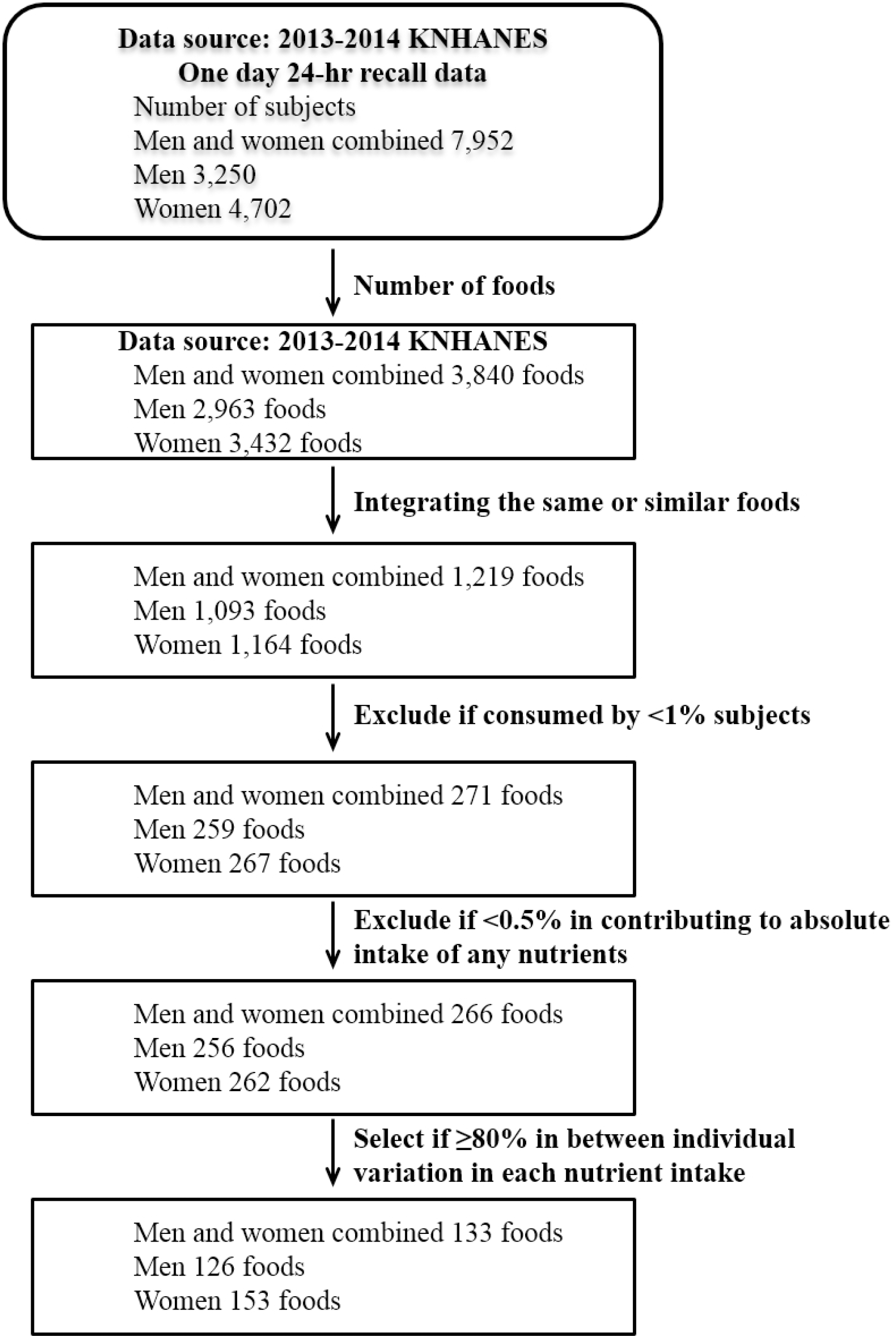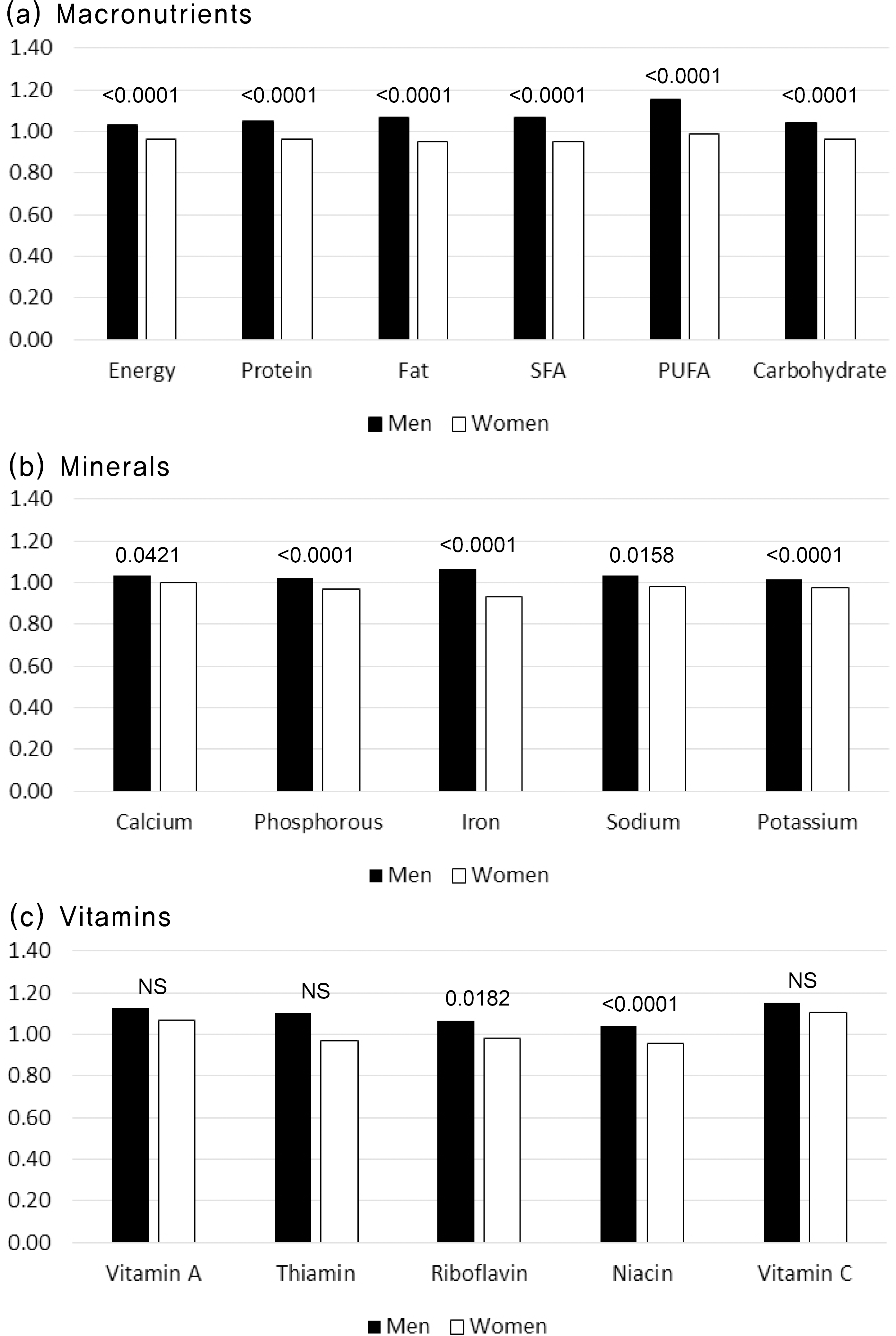Abstract
Background
Methods
Results
Conclusions
References
Table 1.
| Characteristic | Total (n=7,952) | Men (n=3,250) | Women (n=4,702) | Pa |
|---|---|---|---|---|
| Age, y | 43.4±12.4 | 43.3±12.5 | 43.5±12.3 | 0.3736 |
| Age group | ||||
| 19–29 years | 1,237 (15.6) | 523 (16.1) | 714 (15.2) | 0.4030 |
| 30–49 years | 3,830 (48.2) | 1,571 (48.3) | 2,259 (48.0) | |
| 50–64 years | 2,885 (36.3) | 1,156 (35.6) | 1,729 (36.8) | |
| Residential areab | ||||
| Rural | 1,385 (17.4) | 616 (19.0) | 769 (16.4) | 0.0005 |
| City | 2,980 (37.5) | 1,244 (38.3) | 1,736 (36.9) | |
| Metropolitan | 3,587 (45.1) | 1,390 (42.8) | 2,197 (46.7) | |
| Household income, monthly, won | ||||
| ≤2,000,000 | 1,939 (24.5) | 717 (22.2) | 1,222 (26.1) | 0.0009 |
| 2,000,000–3,500,000 | 2,227 (28.1) | 944 (29.2) | 1,283 (27.4) | |
| 3,500,000–5,000,000 | 1,762 (22.3) | 733 (22.6) | 1,029 (22.0) | |
| >5,000,000 | 1,988 (25.1) | 843 (26.0) | 1,145 (24.5) | |
| Education | ||||
| Middle school or less | 1,445 (21.1) | 461 (17.2) | 984 (23.6) | <0.0001 |
| High school | 2,722 (39.7) | 1,081 (40.2) | 1,641 (39.4) | |
| College or more | 2,685 (39.2) | 1,144 (42.6) | 1,541 (37.0) | |
Table 2.
a Candidate foods: foods which have high possibility of being included in food frequency questionnaire items, which were identified as foods with high contribution to total energy and major nutrient intakes as well as foods of major sources of between-person variation in energy and nutrient intakes.
Table 3.
| Nutrient | Men (n=3,249) | Women (n=4,699) | ||
|---|---|---|---|---|
| From candidate foods of total participantsc | From candidate foods of mend | From candidate foods of total participantse | From candidate foods of womenf | |
| Macro nutrients | ||||
| Energy, kcal | 1934.4±929.9 | 1915.6±921.6g | 1343.5±649.7 | 1399.4±660.4g |
| Protein, g | 59.4±40.7 | 59.4±41.3 | 42.3±27.6 | 44.2±28.1g |
| Fat, g | 39.2±37.3 | 38.8±36.8h | 28.0±26.9 | 29.8±27.5g |
| Saturated fatty acid, g | 12.2±12.7 | 12.0±12.4 g | 8.6±9.4 | 9.1±9.6g g |
| Polyunsaturated fatty acid, g | g 9.2±9.3 | 9.0±9.1g g | 6.8±7.4 | 7.1±7.4g g |
| Carbohydrate, g | 284.7±124.7 | 280.6±122.3g | 219.8±105.6 | 228.4±107.2g |
| Minerals | g | g | ||
| Calcium, mg | 392.7±276.7 | 389.3±275.1g | 322.4±253.1 | 332.4±247.4g |
| Phosphorous, mg | 918.7±499.6 | 917.8±503.1 | 703.8±426 | 730.0±429.8g |
| Iron, mg | 14.1±63.5 | 13.7±63.5g | 10.0±6.6 | 11.0±7.1g |
| Sodium, mg | 3240.2±2757.3 | 3303.2±2742.2g | 2187.6±1915 | 2329.4±1950.5g |
| Potassium, mg | 2520.1±1421.7 | 2521.3±1405.3 | 2120.2±1360.4 | 2186.7±1380.1g |
| Vitamins | ||||
| Vitamin A, μgRE | 550.2±642.2 | 526.1±598.2g | 457.8±565.8 | 479.2±579.2g |
| Thiamin, mg Riboflavin, mg | 1.9±1.1 1.2±0.8 | 1.9±1.1 1.2±0.8 | 1.4±0.8 0.9±0.6 | 1.4±0.8g 0.9±0.6g |
| Niacin, mg | 13.6±8.8 | 13.5±9.1 | 10.2±6.5 | 10.7±6.6g |
| Vitamin C, mg | 68.2±97.5 | 71.3±99.6g | 79.9±122.3 | 81.1±122.6g |
a Candidate foods: foods which have high possibility of being included in food frequency questionnaire items, which were identified as foods with high contribution to total energy and major nutrient intakes as well as foods of major sources of between-person variation in energy and nutrient intakes.
b Among the participants (men, n=3,250; women, n=4,702), those who did not consume the candidate foods (men, n=1; women, n=3) were excluded from the nutrient intake comparison.




 PDF
PDF ePub
ePub Citation
Citation Print
Print




 XML Download
XML Download